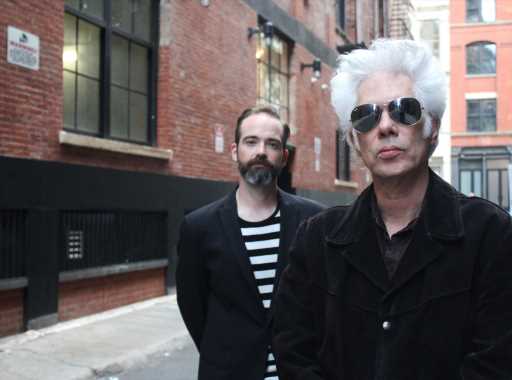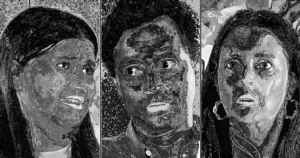The first time Jim Jarmusch came to Cannes was with his sophomore film Stranger Than Paradise, which played the Quinzaine in 1984. “We all shared one apartment that had no hot water, that was up the hill,” he recalls. “One day I had to be on TV and there was no water, so I had to shave with leftover tea.” Those days are long gone; Jarmusch is a fixture on the Croisette these days, and even had the dubious pleasure of opening it in 2019 with his Bill Murray-starring zombie comedy The Dead Don’t Die.
This year he arrived at the festival with a piece for Cannes Classics called The Return to Reason, a work-in-progress restoration of four films by American artist Man Ray shot in Paris during the early 1920s. Featuring a live soundtrack by SQÜRL, the band Jarmusch formed with Carter Logan in 2009, it is essentially a concert movie featuring the hypnotic sounds conjured up in February this year, ranging from trippy, avant-garde drone to a more traditional, Stooges-style aural assault.
Related Story
Hong Sangsoo's 'In Our Day' Sells To Cinema Guild For North America — Cannes Market
When Jarmusch and Logan sat down with Deadline to discuss the movie, the New York-based auteur revealed that he was using his trip to the festival to source financing for a new project that he hopes to start shooting by the end of this year. What would he reveal about it? “I prefer not to reveal much of anything about it,” he deadpanned. “I have an incredible cast, though. I’ll just say this. It makes Paterson — if you saw Paterson —look like a Jean Claude Van Damme action film. It’s very quiet. So that’s about all I’d like to say about it. But I’m excited to be working with some of these actors.”
DEADLINE: Jim, you’ve just recently released an album, “Silver Haze”. Does it bear any resemblance to the music you’ve done for this project?
JIM JARMUSCH: I don’t know. I guess all the music we make is soundtrack music, in a funny way that doesn’t need images to go with it. Our album’s a little bit more diverse. In the past, on the records we’ve made — mostly EPS or soundtracks — most of the music is of the same vein, but it has different things. For this album, Charlotte Gainsbourg, Anika, Marc Ribot are our guests. [Pauses] I don’t know how to analyze anything I do, nor do I try to, but it’s all part of the same thing.
DEADLINE: How did the Man Ray project come about?
JIM JARMUSCH: Many years ago, maybe 15 years ago, I was talking with a girl here, the daughter of my friend Jean Labadie of Le Pacte, who has helped me finance my films. She was 15 or so at the time. She was a cinephile, and I love teenagers. I get a lot of info from them, I get inspiration. I was telling her I wanted to make a live score to a silent film, and she says, “What are you looking at?” I was like, “Well, I like this Renoir film, La Fille de l’eau, [AKA The Whirlpool of Fate, 1925). It’s kind of magical but it’s not quite what I’m thinking.” And she just said, “You must do the Man Ray films, Jim.” I’d only seen two of the four. And I was like, “Of course, the Man Ray films.” So, I just followed the advice of Alice Labadie, a teenager, although I think she’s around 30 now.
So, it came about really by her suggestion. But I knew about Man Ray. When I was a teenager, I discovered Dada and Surrealism, which opened up everything for me. And at the same time, or a little later, I discovered psychedelic drugs. And there was an interconnection there, which involved altered consciousness. Now, we don’t use those drugs, but somehow our music is sort of psychedelic or psilocybin-esque, in a way. And it suits the films, I think.
DEADLINE: Are they restored? What’s the historical background?
JIM JARMUSCH: We’re in the process of restoring them. In fact, Carter and I are kind of proudly responsible for the restoration by touring with them and doing this live. The producer, Marieke Tricoire, we worked with on a short film I made for Saint Laurent three years ago. Oddly enough, her company’s called Woman Ray. That was before we ever met her and knew anything about her. And then she wanted to help facilitate the restorations, which mostly she and [producer] Julie Viez have done. They’re mostly in progress, although one film, Les Mystères… is not. We cannot locate any original materials. So, they’ve found the best there is. That one’s a little complicated. Also, the score here [in Cannes] is not the final mix. All this has been quite quick. It’s a live recording from Paris, from when we played at the Pompidou Center [in February]. It’s beautifully recorded, technically, but not mixed, because it all happened so fast. We get another pass at that because the visual restoration’s not totally complete.

DEADLINE: It must a difficult restoration to approach, because some of the grain and the wear and tear actually adds to the texture…
JIM JARMUSCH: Oh yeah. No, you don’t want to remove anything. We just want to bring it as close as we can. Here’s the beautiful thing: They found hidden things in layers of the film, like a beautiful reclining nude photograph of Kiki de Montparnasse, Man Ray’s girlfriend back in the ’20s. And we’re not sure; did Man Ray reuse other material or did he hide those images in there? Because they’re, like, three frames long. Subliminal, in a sense. You wouldn’t register them of course. But also, film runs vertically, and the image is horizontal. Man Ray was quite a character, a troublemaker in some ways.
DEADLINE: We’ll come back to that, but how do you prepare for a live score? How do you work out what you’re going to do?
JIM JARMUSCH: Oh, yes. We’ve been doing it for a while. Like, 12 years or so, off and on, and so we have a map that we follow, but every performance is different because we can’t follow the map that well. We want it semi-improvised, but we have a map for sure. We’ve rehearsed and played it a lot, but it’s not traditionally a score where we must hit certain beats. Also, Man Ray doesn’t want you to. If you see a train, he probably would rather you hear the sound of the ocean. So, it’s very dreamlike, and we have a lot of freedom in there.
I hope Man Ray would like it. We bring that sort of psilocybin element to the films. What’s really fun is that occasionally Carter will be playing electronic drones and I’ll be playing guitar feedback or electronics, and there will be times when we don’t know who’s playing what. And that’s when Carter and I say it’s like ecstatic music, because even we don’t know what’s happening. We don’t face the screen, obviously, but we have monitors so we can follow the films.
DEADLINE: Is it always just the two of you?
JIM JARMUSCH: Just the two of us. When SQÜRL, our band, plays live we play as a trio lately with a bass player, but we’re not playing with images.
DEADLINE: The drum sections in the film are pretty intense.
JIM JARMUSCH: I love when Carter plays drums. When we play live, it’s guitar, drums, and bass.
[Carter Logan joins the conversation.]
JIM JARMUSCH: [To Carter] We’ve talked about our improvisational element. Our map, which we like. What else did we talk about? How Alice Labadie generated this project years ago. [To Deadline] I say this in a lot of interviews, but she was a teenager, and teenagers really are important to me as guides, cultural guides, because style comes from teenagers and a lot of music does too. And so, I try to stay very open to teenagers. The older I get, the more I appreciate them. They don’t know what the fuck is going on, because they have hormonal stuff and it’s that time when you’re still a child, you’re not a grownup.
CARTER LOGAN: But at the same time, they kind of know everything that’s going on about things that adults know nothing about. So, if you can be attuned to that, and sensitive to their sensitivities, their hormonal mood fluctuations and whatever else, you can gain a whole insight into an entire world that otherwise you have no entry into.
JIM JARMUSCH: Think Rimbaud, think of Mary Shelley, think Joan of Arc. Teenagers fucking rule in a lot of ways, for me.
DEADLINE: It’s funny you mentioned that you discovered Man Ray as a teenager. So did I, because I’d been researching Surrealism and I realized I didn’t actually really like surrealism that much. I much preferred Dada because it was the punk precursor…
JIM JARMUSCH: Well, I started with Dada first and then led me further. I was into the whole Zürich scene and everything. Kurt Schwitters was my aesthetic hero and all these things, so great. But then surrealism sort of extended the next step.
CARTER LOGAN: For me as well. When I was a teenager, it appealed to me. I had similar sensibilities. I was a punk, but my parents had an incredible collection of books. And that was the time that I spent digging through them. I was very interested in the things that were around me. This was pre-internet ubiquity: you had to have guides. And so, for me, my parents were my guides in the beginning, uncovering their record collection, finding my dad’s Otis Redding or Jane’s Addiction cassettes or whatever. And then their book collection as well. And they had a catalog from the MoMA of Dada and Surrealism that was from probably the 1970s or something. And when I discovered that book and flipped it open, it blew my mind. Seeing the Readymades from Duchamp, seeing the Dadaist collages, seeing Man Ray’s sculptures and photographs.
It just opened my mind, I think, to the idea that high art — something that was in the MoMA — could be really punk, that there was actually a deeper history that went way back. I was a teenager in the ’90s, so I discovered that stuff first. And then I went through ’80s hardcore, and the original ’70s punk movements in the UK and the US, all the way back through rockabilly. To see that through-line through music was one thing. But then to see the echoes of art and how that resonated at the time, you can see how that aesthetic carried through, because it’s part of counterculture.

DEADLINE: [To Carter] Before you arrived, Jim was just about to talk about Man Ray as a troublemaker. I often forget that Man Ray is American, was American, but his background was very much like Andy Warhol’s: he was from an industrial city and reinvented himself in a similar way. What appeals to you about him as an artist?
JIM JARMUSCH: Well, a lot. So many things. His parents were Jewish emigres to New York, his mother was a seamstress, and his father was a kind of tailor. And what I love is throughout all of his work, you see elements of things, practical, physical elements, buttons, rolls of cloth, shirt collars. All those things that were around him, he just used and transformed to be some other thing. I love that so much about him. And I just love his openness to all these different forms. He was a painter, he designed jewelry and lamps, and he was a filmmaker. He used very experimental processes in photography, like camera-less photography, and he also lived a really interesting life. And his friends were incredibly interesting. So yeah, I liked the way he lived his life too.
CARTER LOGAN: In New York he lived in a kind of commune, an artist’s collective in Northern New Jersey that, when you read about it now, this sounds like a 1960s, hippie type of thing. But oh no, this was the early 1900s. He worked doing mechanical drawing, trying to sell paintings, but lived as an outsider and then gradually met other artists who had the same kind of affinity. And that really then exploded once he moved to Paris.
DEADLINE: It’s interesting how readily his work translates to fashion. He moved seamlessly in and out of that world.
JIM JARMUSCH: Well, yeah. Other people I love have done that too. Even Robert Frank did fashion photography for a period, but Man Ray was not bridled by any particular form. Collages, sculptures. He did all of it. He was just playing with stuff and very playful all the time.
DEADLINE: Jim, is he on the wall of influences in Only Lovers Left Alive?
[Laughs] I think he’s not, but I had too many. That could have been five walls. I recently found the list and it was like five times as long. I remember the production designer saying, “We have to clear these too.” And some of them I couldn’t clear, they wouldn’t allow us. Francesca Woodman’s parents wouldn’t let me use a photo of her.
CARTER LOGAN: I think these are the things about Man Ray, that we tried to carry forward with the music, the sense of playfulness. When we play, it’s almost like we’re playing a game of chess sometimes, because we have the board. The films are the board. The board doesn’t change, and the pieces don’t change.
JIM JARMUSCH: He designed his own chess pieces, and his favorite thing in the world was to play chess with Marcel Duchamp. That’s what he would rather do than make art or even have sex with Kiki de Montparnasse.
CARTER LOGAN: So, if we can create or take some of that as inspiration, what that translates into is making musical moves that each other can respond to in real time within a certain parameter. It’s not just freeform. We’re not doing completely improvised experimental music.
JIM JARMUSCH: But here’s a weird thing. We’ve played this set a lot. We did a tour where we played, in two and a half weeks, 18 shows or something. And then when they sent us the recording from the Pompidou Center of our score, we realized, “Oh shit, we’ve never watched the films with our music because we’ve been too busy creating it.”
DEADLINE: Do you ever rehearse it? Is the spontaneity a key ingredient?
JIM JARMUSCH: We rehearse, but we can’t… [Pauses] It’s not exactly akin to this, but one of my favorite quotes of John Lennon is “Originality comes from not quite being able to imitate your greatest inspirations.” So, it’s like we’re not able to do a traditional score, and we’re playing electronic stuff, electric guitar. We’re not classical, orchestral musicians. We come from punk rock and all this and shoegaze and stuff.
CARTER LOGAN: And there’s just two of us.
JIM JARMUSCH: We’re half-and-half. We’re improvising from a map, so we’re following the map. But sometimes we also diverge. It’s the way I make films. I have a script as a blueprint. I’m not rigid, because things happen when they happen. And often the most beautiful things are the things you didn’t quite plan for or were accidental even. And that’s certainly true in how we approach music, for sure.
CARTER LOGAN: I think that there’s something in that about how Man Ray approached cinema as well. Each of these films had a slightly different approach, but none of them really had a formal script. There were poems to guide. Robert Desnos expanded on the poem for Étoile de Mer [The Starfish] in order to help that grow a little bit more because it was a kind of automatic poem originally.
JIM JARMUSCH: Well, he also collected cool stuff and then built things out of it because you see certain things repeat in different films, certain pieces of sculpture. He just had a lot of cool stuff to make the films out of, I think.
CARTER LOGAN: Le Retour à la Raison is definitely that. He considered it a Dadaist film. It was his earliest, and it really was trying to follow some of the rules of Dada and do things that were unexpected. But, yes, he just experimented. Sometimes he didn’t even run the film through a camera. He used his rayograph technique to lay it out in a dark room and put things on top of it. And that’s where you get these really wild visuals, which in fact are salt or thumb tacks different objects on the film. It took me some time to really understand all of that.
JIM JARMUSCH: Le Retour à la Raison is the title that Marieke chose. Me, I would’ve chosen the title Belle Étoile d’Ivresse — A Beautiful Star of Inebriation. But the thing is, retour à la Raison is ironic, it’s from 100 years ago and he’s saying we should return to a reasonable way of appreciating the imagination. He’s trying to say that the world is fucked up, so let’s go to the lack of reason. The kind of reason he’s talking about is unbridled imagination. Marieke loves that title because of the state of the world now, but he was saying this in the ’20s, after the First World War. [Laughs] It’s kind of an ironic statement…
Must Read Stories
Max Reverses Credits Display After DGA & WGA Blasted It As “Insulting”

‘Asteroid City’ Coverage; Breaking Baz @ Zaslav’s Hotel Du Cap Party

‘Little Mermaid’ To Be Part Of That World With $180M Global Start: Preview

‘Mrs. Davis’ EP Tara Hernandez On WGA Strike Solidarity, Solitary & ChatGPT

Read More About:
Source: Read Full Article


